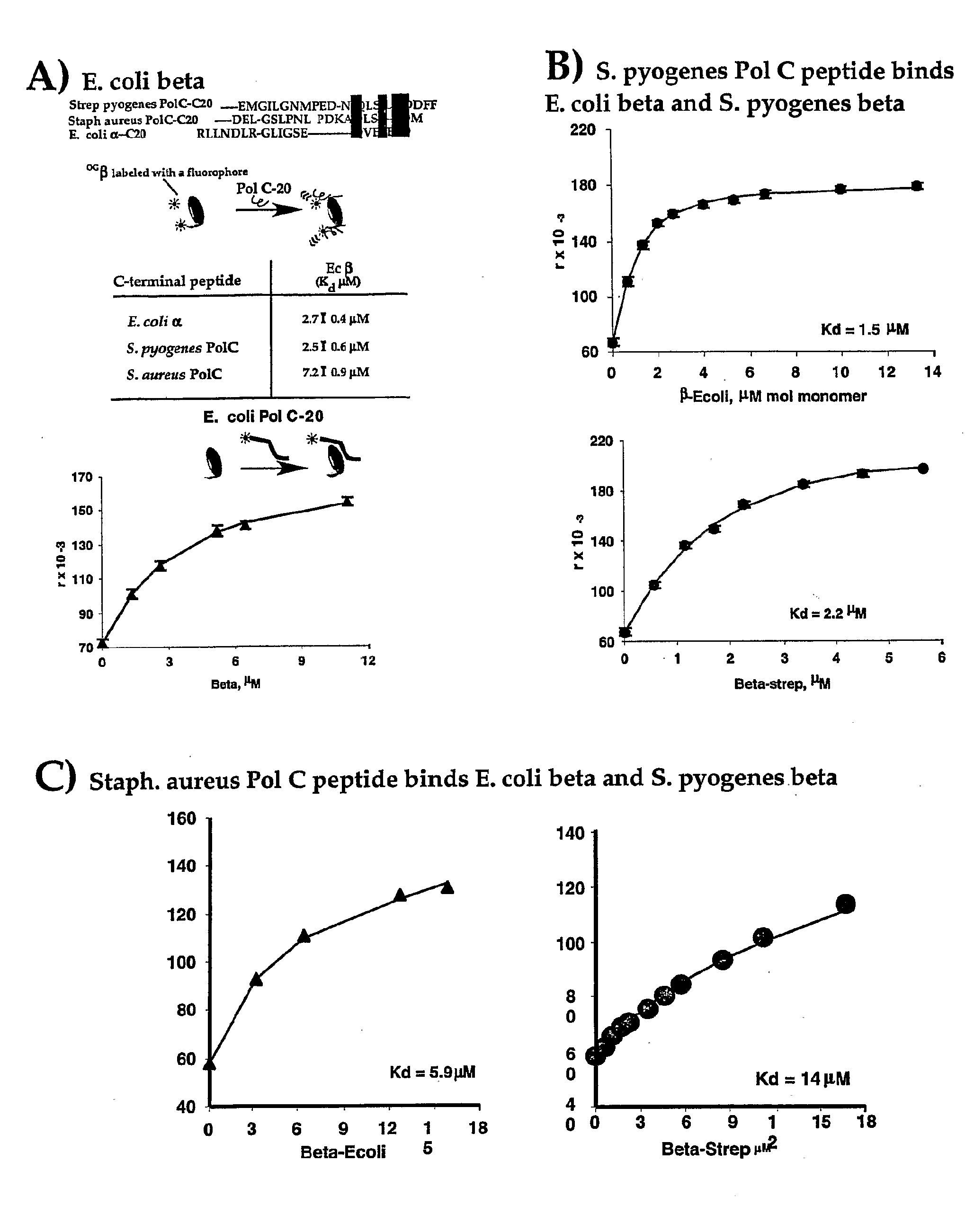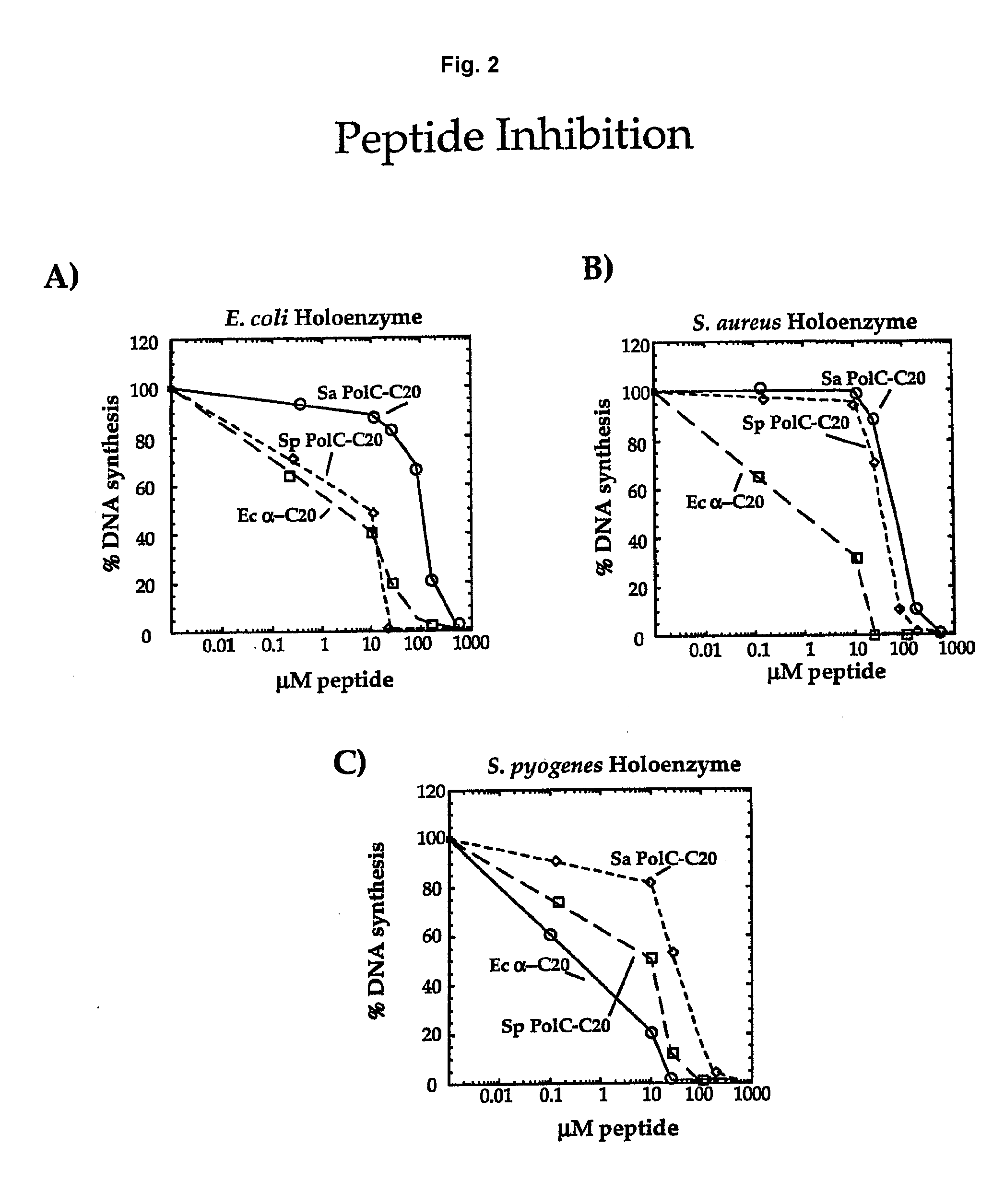Method of Identifying Compounds for Bacterial Growth Modulation
a growth modulation and compound technology, applied in the field of compound identification for bacterial growth modulation, can solve the problems of low solubility of hp-ura chemical class in general and have not found application as a drug, and achieve the effect of minimizing toxicity and optimizing activity
- Summary
- Abstract
- Description
- Claims
- Application Information
AI Technical Summary
Benefits of technology
Problems solved by technology
Method used
Image
Examples
example 1
Materials
[0079]Labeled deoxy- and ribonucleoside triphosphates were from Dupont—New England Nuclear; unlabelled deoxy- and ribonucleoside triphosphates were from Pharmacia—LKB; E. coli replication proteins were purified as described, alpha, epsilon, gamma, and tau (Studwell, et al., “Processive Replication is Contingent on the Exonuclease Subunit of DNA Polymerase III Holoenzyme,”J. Biol. Chem., 265:1171-1178 (1990), which is hereby incorporated by reference in its entirety), beta (Kong, et. al, “Three Dimensional Structure of the Beta Subunit of Escherichia coli DNA Polymerase III Holoenzyme: A Sliding DNA Clamp,”Cell, 69:425-437 (1992), which is hereby incorporated by reference in its entirety), delta and delta prime (Dong, et. al., “DNA Polymerase III Accessory Proteins. I. HolA and holB Encoding δ and δ′, J. Biol. Chem., 268:11758-11765 (1993), which is hereby incorporated by reference in its entirety), chi and psi (Xiao, et. al., “DNA Polymerase III Accessory Proteins. III. Hol...
example 2
An Assay for Binding of the C-Terminal Residues of Bacterial Pol C (Pol III) Polymerases to the β Camp
[0080]A simple and quantitative assay has been developed to monitor binding of a E. coli Pol III peptide to E. coli beta (López de Saro, F. J., et. al., “Competitive Processivity—Clamp Usage by DNA Polymerase During DNA Replication and Repair,”EMBO J., 22:6408-6418 (2003), which is hereby incorporated by reference in its entirety). A rhodamine-labeled 20 mer peptide corresponds to the sequence of the C-terminal 20 residues of E. coli Pol III α subunit. Titration of the beta clamp into the rhodamine labeled peptide resulted in a fluorescence increase of the rhodamine labeled peptide upon binding to the beta molecule. A plot of the fluorescence change with beta concentration provides a Kd value for the interaction between these molecules (FIG. 1A).
[0081]This assay has also been examined using Streptococcus pyogenes β and rhodamine labeled peptides corresponding to C-terminal residues ...
example 3
Polymerase Peptides Inhibit Bacterial Replicases
[0082]Assays were performed using primed M13mp18 ssDNA coated with SSB as substrate. Each reaction was 25 μl and contained 72 ng primed M13mp18 ssDNA, 1 μg SSB, 0.1 mM MgCl2, 20 mM TrisHCl (pH 7.5), 0.1 mM EDTA, 5 mM DTT, 40 μg / ml BSA, 4% glycerol, 0.5 mM EDTA, 2 mM ATP, 60 μM each of dCTP, dATP, dGTP and 20 μM α32-P dTTP. Replicases consisted of the following for each E. coli, S. pyogenes, and S. aureus: 50 ng Pol III core (E. coli) or Pol C (S. pyogenes and S. aureus), 200 ng τ, 20 ng δδ′ and 40 ng β. Peptides, when present, were added to the indicated concentration. Reactions were assembled on ice in the absence of the polymerase, then shifted to 37° C. for 3 min before initiating synthesis by addition of the polymerase. Reactions were incubated a further 3 min prior to quenching and quantitation of synthesis.
PUM
 Login to View More
Login to View More Abstract
Description
Claims
Application Information
 Login to View More
Login to View More - R&D
- Intellectual Property
- Life Sciences
- Materials
- Tech Scout
- Unparalleled Data Quality
- Higher Quality Content
- 60% Fewer Hallucinations
Browse by: Latest US Patents, China's latest patents, Technical Efficacy Thesaurus, Application Domain, Technology Topic, Popular Technical Reports.
© 2025 PatSnap. All rights reserved.Legal|Privacy policy|Modern Slavery Act Transparency Statement|Sitemap|About US| Contact US: help@patsnap.com



